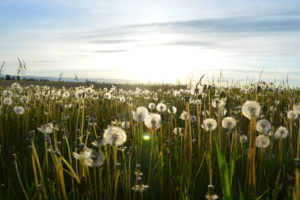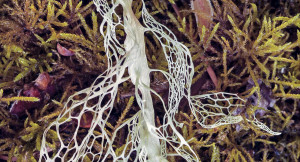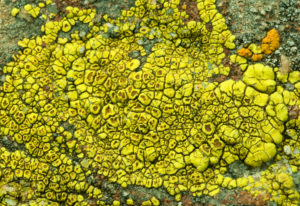aura Baker crouches in the scrub on the northwestern side of Oakland’s Knowland Park. Peering through her hand lens, she examines the branches and burls at the base of a brittle leaf manzanita. Above her a coast live oak—sturdy and gnarled—arches its branches over crowns of the chaparral, forcing the sunlight to filter through in shards.
“How does it feel in here compared to the fire trail?” she asks. “Different?”
Baker has hiked through dry grass to the middle of the thick chaparral, where the summer morning’s gray bluster has faded into quiet warmth. Here, in this microclimate where the roots meet the soil and the morning fog drips through the branches, flourishes one of nature’s smallest communities—lichen.
Laura Baker, a member of the California Native Plant Society (CNPS) East Bay Chapter, is part of a collaborative project with the California Lichen Society to identify and collect lichens in Knowland Park.
“Lichens have not been well understood or heavily studied in the way that plants or animals have,” Baker said. “But people have begun to learn more about them, which means we’re now in a position where conservation can begin to take place.”
The refuge for many of the lichens in Knowland Park is a remnant stand of maritime chaparral atop a ridge that overlooks much of San Francisco Bay, including San Leandro Bay, the outlet for Arroyo Viejo Creek which has its headwaters in Knowland Park. Fog travels in through the Golden Gate and across the Bay, carrying its moisture up to the ridge of the hills where maritime chaparral occurs. While interior chaparral is common in California, old-growth maritime chaparral has become increasingly rare, with a dozen small sites in the East Bay that form a 20-mile archipelago along the spine of the hills. Knowland Park lies at the southern end of the chain but still within reach of the coastal fog. So, while the highlands of the park are relatively hot and dry, Baker says six coastal species manage to survive among the dozens of lichen species found there.
“It can be dry as heck out there,” Baker says, “but the dense chaparral canopy tends to dampen winds, trapping humidity.”
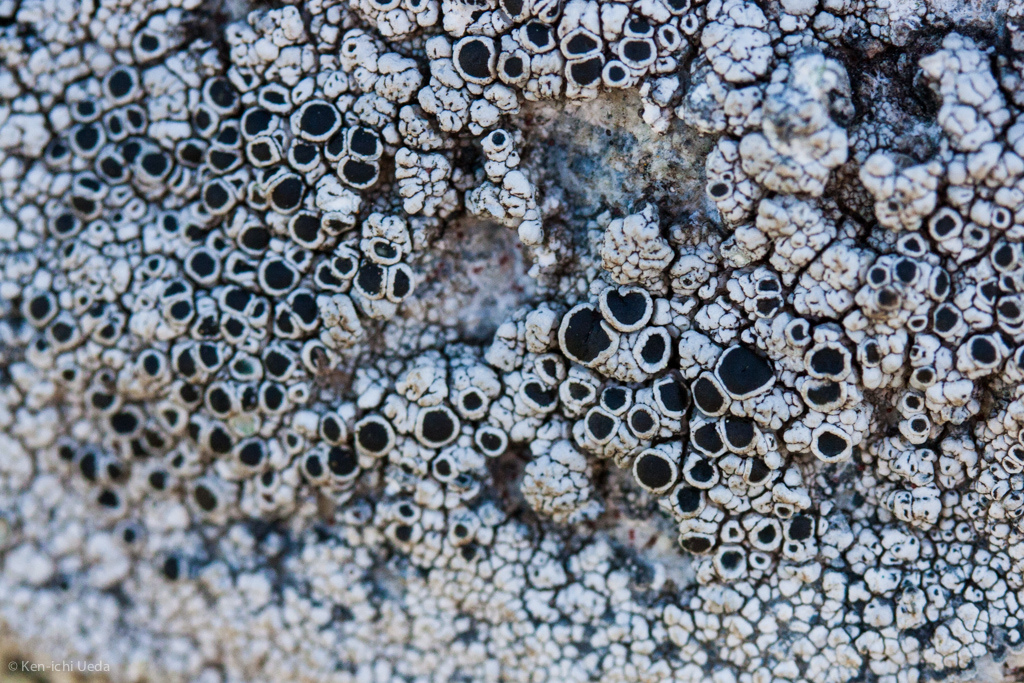
Amid a chamise-thick patch of maritime chaparral, Baker picks up one of the many dead branches blanketing the undergrowth. Many of these branches play host to an array of lichen species. There is the crustose variety that attaches itself to rocks and branches in a thick, bumpy crust. The foliose variety, flat and leafy, with a distinct different underside. And the fruticose variety that grows in tufts of coral-like structures, barely, if at all, clinging to the branches.
Lichens are a composite organism–a symbiotic partnership between algae and fungi–and are considered part of the fungi kingdom. The alga gives lichen its ability to photosynthesize and provides the fungus with a food source, while the fungus gives the lichen most of its physical characteristics, including its thallus structure which protects the single-cell alga. Lichen pigment determines the lichen’s color and shields it from harmful ultraviolet radiation. One species found in Knowland Park, Xanthoria parietina, will appear greenish if growing in the shade and orange when growing in the sunlight.
At a glance, these lichens seem to be no more than a pastel crusting of greens, yellows and grays. Through a hand lens, their microscopic world appears in three-dimensions: Leafy structures nestled upon one another make up the coral-like Physcia callosa, while the gray Thelomma occidental is mottled with black dots, closely resembling potato eyes. Magnified through a dissecting scope, the microscopic and largely unknown world of lichen fauna emerges. While Baker was looking at a lichen sample from Knowland Park a line of peppermint striped mites, less than the size of a pinhead, marched into focus.
“There’s this whole world of tiny invertebrates that are part of the lichen community and form the basis of an elaborate ecosystem,” she says.
Despite their sturdy-looking exteriors, lichen are highly sensitive to changes in air quality and respond to varying levels of nitrogen and sulfur. Some lichen varieties such as the yellow Candelaria thrive in areas with high nitrogen deposition, which often correlates with high levels of air pollution. Conversely, some species of “old man’s beard” struggle in high nitrogen levels and their numbers will diminish in areas of high air pollution. For this reason lichens have been used in science to monitor air quality.
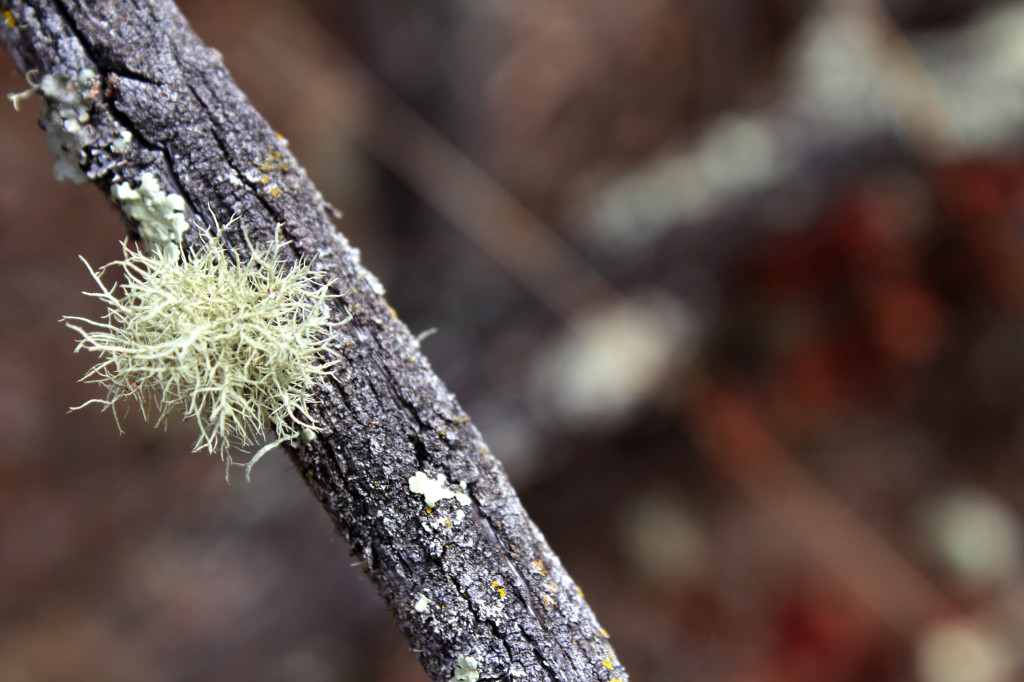
It is the early fall and after a dry summer, Knowland Park is a yellowed landscape. The native grasses have been chewed to a nub by the goats that graze during the summer, and piles of invasive french broom, removed by volunteers, are lined up across the dirt. But this parched land continues to serve as a refuge for Oakland’s city fringe wildlife, chaparral and lichen that have only ever known Knowland Park as open space.
Baker says she worries that a plan for the Oakland Zoo to annex 56 acres atop the park’s ridgeline could threaten the diverse universe of lichens in the maritime chaparral stands. Should the expansion go ahead, much of the chaparral and its lichen communities, will be fenced within the zoo’s new boundaries, with no guarantee of its conservation.
Outside of the dense chaparral it is warm but windy and across the Bay, Mount Tamalpais is just a bump on the horizon. Back on the fire trail, Baker leads the way to a rocky outcrop encrusted with crustose lichens that will grow on anything from a tree stump to a fence post. They are orange, gray and chartreuse in color and up close, as Baker describes, seem to have somewhat of a bathroom tile pattern. Outside the boundaries of the zoo’s proposed expansion, these lichens will most likely be preserved. But looking down from the rocky hill at the red-stained manzanita chaparral enveloped by that gnarled oak, it is hard to imagine this landscape clouded by a chain link fence.
“All of this is free,” Baker says. “Anyone can come here and get a glimpse of what California once looked like—why would you destroy that?”
Alessandra Bergamin is the Bay Nature Interim Online Editor.


